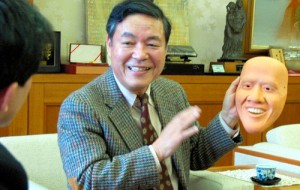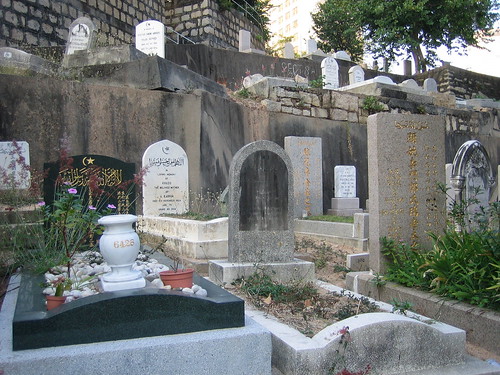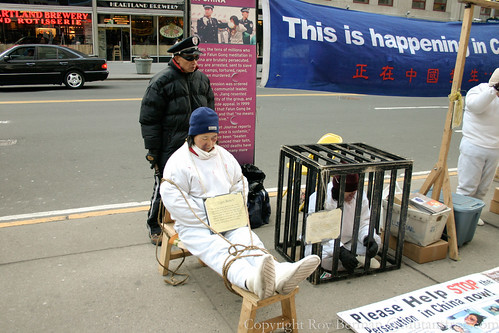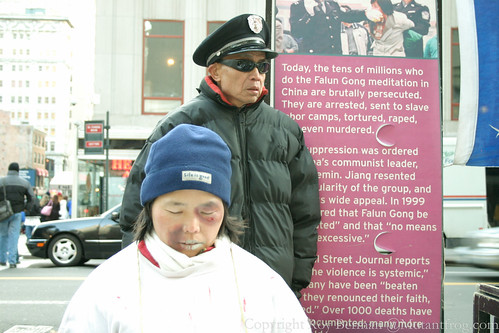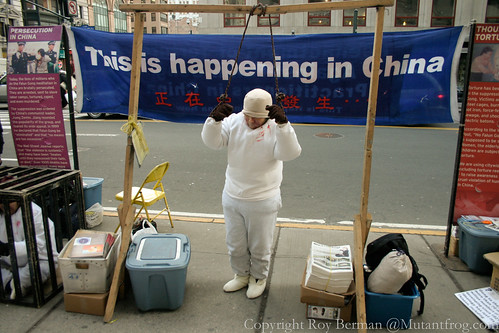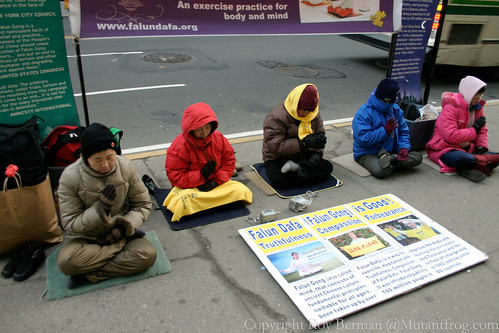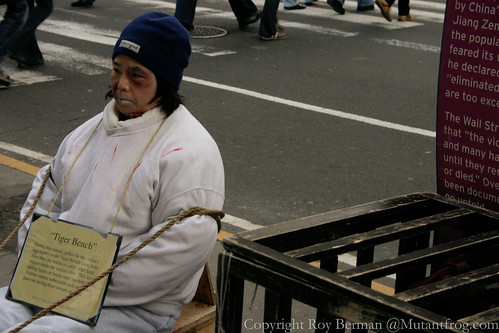Our friend Curzon over at the Cominganarchy blog posted last week an excellent piece on the history of the involvement between the familes of the Reverend Billy Graham and the Kim dynasty of North Korea. The connections are, as usual, longer and more interesting than one would expect from just reading the news. I highly recommend reading it.
Category: Religion
The Masonic Bible
Slate’s Explainer column is always a good read, but this week’s installment on the bibles used for presidential inaugurations was particularly amusing.
George W. Bush wanted to use the Washington Bible for his first inauguration, as his father had done, but the plan was foiled by drizzly weather. The Masons are extremely careful with the Washington Bible: They refuse to let the artifact be X-rayed at airport security and demand that the president be the only one who touches it without gloves.
In Japan, Obama inauguration inspires English lessons, off-kilter likenesses
1. Learn English
- Listening to one of the great speechifiers of our time can be inspiring. Obama’s message can call you to serve your country, resolve to be a better person, or sacrifice for the greater good (but tragically apparently not to prosecute those responsible for the Bush regime’s crimes). Some aspiring English speakers in Japan have taken this opportunity to brush up on their own speaking skills. Prominent among the “Obama books” that are currently flooding Japanese bookstore displays is CNN’s Obama Speech Collection for students of English as a second language. The book, so far having sold over 400,000 copies, features excerpts from famous Obama speeches with a Japanese translation on the opposite page, which students can use to follow along as they listen to an attached CD. I picked it up the other day and it has proven useful both as a translation reference for US politics and as a handy record of his landmark addresses. I’m not sure how effective it is as a teaching tool, but for a Japanese learner of English inspired by Obama it will no doubt give them easy access to the tools they need (minus the inauguration address, of course).
- Meanwhile, much like Kenya’s “Obama imitation contest“, some private English classrooms have started offering Obama mimicry lessons to a reportedly favorable response. In one TV news report, groups of 20+ students lined up to wait their turn to recite famous Obama speeches as a White-boy instructor barked orders on how to mimic Obama’s unique oratory style.
2. Create a mildly unsettling Obama likeness
Here we see some examples of creativity from both traditional and modern artists that deserve an “A” for effort but unfortunately didn’t turn out all that appealing:
- Obama Noh mask, gifted from Kyoto to Obama City, Fukui Prefecture:
- Obama nativity scene, by fence maker Mikami Industries of Higashi-Osaka (check out the whole slideshow from Sankei, or take a tour of the mini White House via the Mikami site):
- UPDATE: Thanks to Matt Alt, I can now show you the (not Japanese but still cool and available in Japan) unofficial Obama action figure, from Japanese Hong Kong firm DiD Corporation:

* Thanks to Andrew Leonard for the correction!
Compare to the real thing:

That’s more like it!
Inventing Xmas
Christmas is over but “the holidays” continue.
As you recover from over-eating, you might enjoy reading about how America’s modern Christmas traditions were born. About.com has a concise guide. One interesting tidbit on the first depiction of the modern Santa:
Santa’s suit features the stars and stripes of the American flag, and he’s distributing Christmas packages to the soldiers. One soldier is holding up a new pair of socks, which might be a boring present today, but would have been a highly prized item in the Army of the Potomac.
Beneath Nast’s illustration was the caption, “Santa Claus In Camp.” Appearing not long after the carnage at Antietam and Fredericksburg, the magazine cover is an apparent attempt to boost morale in a dark time.
If you saw the Colbert Christmas Special, you might remember Toby Keith singing “Santa Claus and Uncle Sam are one and the same.” I guess there was more truth to that than is widely recognized!
The Viceroy’s many connections in the Orient
Two of the three bloggers at Cominganarchy, who go by the online handles of, Curzon and Younghusband, were in the same university in Kyoto where Adam and I did our undergraduate study abroad exchange program while we were there. Curzon, like Adam and Joe, had previously participated in a one year high school study abroad exchange in a different part of Kansai (and a different program from the one Adam and Joe were on), and even before that-12 years ago now-had done a summer program in which he stayed for a month with a host family in Otsu, a small city in Shiga Prefecture located just across the mountains to the east of Kyoto.
Although Curzon spent his first few months of undergraduate study abroad living in the same international students dormitory that Adam and I later lived in (Curzon arrived before us), and which Younghusband had lived in a couple of years earlier, he soon moved out and into one of the very cheap and very old fashioned dormitories that lie somewhere on the continuum of housing between hovel and tenement, with facilities so bare that they would never even be considered a legal residence back in the United States. I say dormitory because while each resident has an individual room-which cost a measly 13,000 yen (around $130) per month-for that price you got just a room, with only a shared toilet and no bathing facilities anywhere in the building. This sort of arrangement used to be typical in Japan, where neighborhood bath houses are still common in many areas, but has understandably fallen out of fashion in a period when most people can afford better.
When I returned to Kyoto earlier this year, I spent the entire month of April living in the spare bedroom of a friend’s apartment, down in Kyoto’s far southern ward of Fushimi so that I would have a base from which to look for someplace else to live. Since I have another friend who was in fact studying with Cuzon, Adam and I back in 2002-03 who will be moving back to Kyoto in September to engage in some other study program, we had decided that, so we would be able to live cheaply and yet still have a decent amount of space, we would rent a house to share after he arrived. However, not wanting to be stuck with a double share of rent for the intervening months, I decided that it would be best to find somplace both cheap and temporary, and if at all possible also located close to campus.
The biggest difficulty here has to do with the way rental leases are often structured in Japan. Even when the actual monthly rent is low, is it typical here to pay an outrageous reikin (often translated as “key money” equal to several months rent, in addition to a month or two of rent upfront, and a deposit equal to a couple of months rent. I considered living in one of those foreigner guest houses for a couple of months, but I visited one and it seemed fairly lame, and I thought I could do cheaper. And I did. I managed to get very lucky and find a place which is very cheap, very well located, and has a contract that I can leave with no penalty. The building is, rather oddly, owned by a monk who actually lived inside the temple on Hiezan, the holy mountain on the NE corner of Kyoto, who is so seriously monk-y that he spent twenty years engaged in a special Esoteric Buddhist meditation where, although he could interact with people, he did not leave the mountain at all. Needless to say, his grasp of modern technology is rather weak.
The apartment is, while old, low-class, and rundown, is however, unlike Curzon’s aforementioned former place, actually an apartment. A small one, to be sure, (a single 6-tatami room and a 2.5 tatami kitchen area separated by sliding doors) but with a (very basic) kitchen, a (Japanese style) toilet, and a bath. What it lacks, however, is a shower. And the bath tap only produces cold water, so you have to fill it up, heat it up with the gas bath heater-that very annoyingly must be turned on from the veranda- and then wash yourself by sitting next to the tub and pouring water on yourself in a sort of poor-man’s psuedo-shower. But, at least there is an air conditioner. While far from ideal, the price was right. ¥25,000 a month, with no reikin, and only a one-month deposit that the monk landlord promises I will get back as long as there is no extraordinary damage. But considering the ragged tatami and old paint that was here when I moved in, the bar for that was set low. I believe that this is the lowest price you could possibly get in Kyoto for a room with private bath, and while on the shabby side, is still a solid two or three steps above the ¥13,000 room.
The landlord occasionaly drops off various gifts, senbei, expensive chocolates, fancy tea, etc. which I find hanging on my door handle every few weeks when I get home from somewhere. These are most likely gifts brought to the temple by parishioners, which the monks then redistribute for some reason. Two days ago I returned home to find a new treat, with an envelope containing the following note attached.
Mr. Roy Berman
It is my very pleasure and astonishment that you and Mr. Curzon my acquaintance should be good friends from the same province.As you know, he stays in Tokyo now, and orders me to serve you as possible!
Koutai
Naturally perplexed, I emailed Curzon to see how this might be, and it turns out that Mr. Koutai (first name) was a friend of Curzon’s host father from his very first stay in Japan, 12 years ago in Otsu. The hostfather had taken the then-teenaged Curzon up Hiezan to meet the monk, and they met again a couple of weeks ago when Curzon visited the old host father in Otsu.
Muslim cemetery in Hong Kong
In Hong Kong over New Year’s, I hopped on board one of the island’s incredibly cheap streetcars and randomly rode from Central, the bustling business center of the city, to the quieter but still absurdly developed alcove of Happy Valley. The district is best known for its racecourse, which (not being a fan of equestrian sports) I first learned about from James Clavell’s very fun novel Noble House.
The name “Happy Valley” comes from the area’s use as a burial ground during the early days of the colony. As was the case in many tropical colonies (see Guns, Germs and Steel), the hot climate and marshy terrain of the island were quite incompatible with the Europeans moving in, and the resulting waves of diseases made Happy Valley one of the most populous areas of Hong Kong (if you’re counting corpses).
Even today, the cemeteries of Happy Valley are its most prominent and unique feature, next to the famous racecourse which is literally right across the street.
One of the more fascinating parts of the cemetery is the Muslim section, which happened to be open as I walked past. The headstones, dating from throughout Hong Kong’s history, are written in varying combinations of Arabic, Chinese and English.
The Muslim cemetery occupies a number of slopes wrapped around a hill, which makes it an excellent vantage point for viewing the lower, flatter Catholic cemetery below. Another case of awesome real estate wasted on dead people.
Raelians in unexpected places
You may remember I posted a few months ago about the highly curious billboard by Nagoya’s central train station sponsored by the alien/free-love Raelian movement. They do pop up in odd places. I was looking through Wired magazine’s gallery of photos from Japan’s “Adult Treasure Expo” and noticed this somewhat curious photograph, accompanied by rather more curious text.

Clitoraid is an non-profit organization set up by the Raelian Movement to help women around the world who have suffered genital mutilation. The Raelians promote an “adopt a clitoris” campaign and claim to facilitate surgical clitoris reconstruction. The woman on the right of the photo is wearing a clitoris costume.
Genital mutilation doesn’t seem to be a big issue in Japan, and the Realians’ adoption of the issue is a mystery. There are several serious nonprofits around the world trying to stop genital mutilation. The Raelians are best known for claiming to have cloned the first human baby, without offering proof.
If you look at Clitoraid’s web site, you can find the following text:
Following the announcement made by Dr Foldes, OBGYN in France, stating that women and children of all ages who have suffered the atrocities of clitoral excision, or female genital mutilation the equivalent of male castration in its barbarity, now have the possibility to regain sexual pleasure and be whole once again, thanks to medical advances and scientific progress. Rael, the spiritual leader of the Raelian Movement decided to help as many women as possible to regain their sense of pleasure and founded Clitoraid, a private non-profit organization with the aim to sponsor those women who want to have their clitoris rebuilt.
Considering the huge number of Burkinabe women who are candidates to be operated on and as Clitoraid received offer from a few doctors to travel to Bobo Dioulasso and help rebuild the clitoris of all the circumcised women, the Prophet Rael declared: “Instead of using Clitoraid’s collected money to operate on just a few women, we should create the first Raelian Hospital, the “Pleasure Hospital”, and operate on all African women, for free, with the help of Raelian or non-Raelian benevolent doctor”.
While offering medical aid to victims of genital mutilation is certainly a laudable goal, I am slightly disturbed that the motivation is because their space alien-inspired prophet told them to. Then again, how is this really different from any other religion?
Falun Gong theatre in New York
The NYT has a rather funny article about New Yorkers who attended what they thought would be a traditional Chinese New Year theatrical spectacle at the Radio City Music Hall, but ended up seeing a very different kind of show.
Then the lyrics to some of the songs, sung in Chinese but translated into English in the program, began referring to “persecution” and “oppression.” Each time, almost at the moment a vocalist hit these words, a few audience members collected their belongings and trudged up an aisle toward the exit.
Before long came a ballet piece in which three women were imprisoned by a group of officers, and one was killed. At the end of the number, more members of the audience, in twos and fours and larger groups, began to walk out. At intermission, dozens of people, perhaps a few hundred, were leaving.
They had realized that the show was not simply a celebration of the Chinese New Year, but an outreach of Falun Gong, a spiritual practice of calisthenics and meditation that is banned in China. More than three years after flooding city corners and subway stations to spread the word about the Chinese government’s repression, Falun Gong practitioners are again trying to publicize their cause. Only this time, it involves costumed dancers and paying audiences in that most storied of New York concert halls, Radio City.
The article then goes on to mention that Faul Gong is well known for their elaborate street theatre protests around the city, in which they use props and stage makeup to dramatize the torture their compatriots are undergoing in China, as they hand out literature on the subject. Here are some photos I took of one such protest back in May of 2005.
Has anyone ever seen something like this anywhere besides New York? I saw Falun Gong protesters in Hong Kong, by Victoria Bay, and handing out flyers and DVDs outside of Taipei’s National Palace Museum (prime location to find tourists from the mainland) but never anything like this sort of dramatic reenactment.
Manila an “anti-birth-control dystopia”
At least, that is how it is described in the words of Carol Lloyd, blogger on women’s issues at Salon.com. Due to the centuries as a Spanish colony, The Philippines is a firmly Catholic country-one in which the Church holds a level of influence rarely seen in the western world. Although the Catholic Church has oddly never managed to have any appreciable effect on the Philippines endemic Southeast Asian liberalism towards homosexuality and gender identity, they have managed to keep abortion illegal in all circumstances but to save the life of the mother. (More information on abortion in SE Asia here.) Although pre-conception birth control remains legal throughout The Philippines, in 2000 conservative Catholic Mayor Jose “Lito” Atienza of Manila issued an executive order removing all contraception from free clinics within the city. Many women in the desperately poor slums of Manila find it impossible to fit contraception in with food and other basic needs into their family budget, which has the eventual effect of a larger and even harder to feed family. This is what has women living in three urban slums to file a lawsuit demanding revocation of the order. From Reuters:
Emma Monzaga, one of the petitioners, said she was getting injections once every three months to prevent her from becoming pregnant, but was told on her third visit to a public clinic that the treatment was no longer available. “I was asked to go somewhere else to get the shots because the city hall has stopped funding the family planning program,” Monzaga said, adding her family could not afford to spend extra for contraceptives. “We used to get it for free. It’s becoming a burden because we have to eat and send our six children to school.” She said she has given up the idea of saving some money from her husband’s 300 pesos ($7) daily wage as a construction worker to pay for the vaccines because of rising cost of basic needs.
Amazingly, it took almost eight years before a local NGO managed to file the lawsuit “because the women feared political reprisals.” Unsurprisingly, there is now a different mayor in charge, and many hope that he will revoke the previous order without the need for the lawsuit to proceed. The Center for Reproductive Rights has a 50 page report, full of testimony, on the issue entitled “Imposing Misery: The Impact of Manila’s Contraception Ban on Women and Families,” which may be downloaded in PDF from their website at the above link. The report claims that the executive order violates the Republic’s 1987 constitution, stating:
The 1987 Philippine Constitution guarantees the
rights to liberty, health, equality, information and education for all citizens,
as well as the right of spouses to found a family in accordance with their
personal religious convictions. These basic principles, reinforced by
several pieces of legislation, create the foundation under national law for a
right to reproductive health, including access to contraception. [p. 9]
The report suggests that “The Manila City government should revoke Executive Order No. 003” as well as various further plans. [p. 11]
While many people look at issues such as these primarily in terms of individual rights and their effect on individuals and families, it is critical to consider the broader picture as well.
The Philippines today has a population of just under 90 million, a staggering number of whom live in poverty. I can attest from my own visit to the country that the cities are clogged with slums, illegal shanty-towns line the rivers and fill public parks, and the ratio of the population with no gainful employment appears to be easily several times that of anyplace else I have ever been. I have even heard that the unemployment rate in Metro Manila may be almost 50%.
Without high quality and aggressive family planning, that 90 million could nearly double in a generation- and the country’s scarce economic resources would be stretched even thinner. Could the unemployment rate rise even above 50%? Will The Philippines be plunged into a Malthusian crisis like Bangladesh or parts of Africa? Lack of birth control is hardly the only factor that has made Manila, and many other third-world regions, into dystopias, but it is one.

